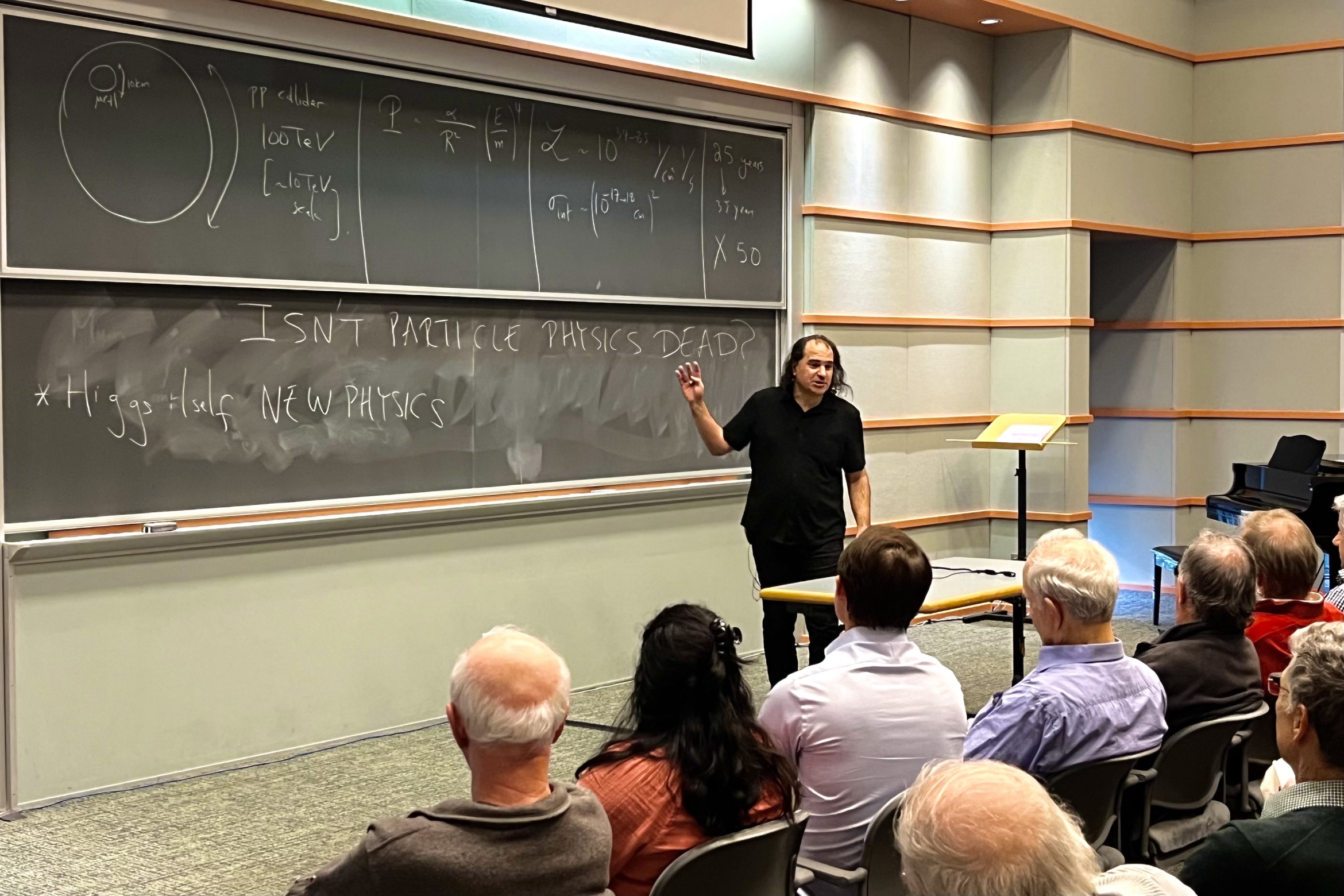
The most powerful particle collider currently lies about 100 meters underground, circling several French and Swiss towns northwest of Geneva. The Large Hadron Collider (LHC) revs up protons to relativistic speeds, smashing them together so scientists can sift through the debris for evidence of new physics.
But the LHC’s grand achievement — the discovery of the Higgs boson — has come and gone, and the collider is reaching the limits of its power output. More discoveries, it seems, will require a new collider. The question is, what type?
Physicists from around the world gathered February 27 through March 10 at UC Santa Barbara’s Kavli Institute for Theoretical Physics (KITP) to discuss the potential for a new kind of experiment: a muon collider. The rapid response program comes on the heels of a formal community discussion effort and aims to provide concrete recommendations to the two influential panels currently plotting the future of high energy physics in the United States.
“KITP was very happy to host this event,” said director Lars Bildsten. “Not only did it bring the particle physics community together to better understand the challenges, it also triggered debates and discussions that will inform those making recommendations to funding agencies about priorities for large investments.”
Proton-proton colliders, like the LHC, can reach high energies due to the proton’s relatively large mass. But protons are composite particles — made of three quarks bound together by the strong nuclear force — so their collisions exchange only a fraction of the energy carried in each proton. And they’re messy.
On the other hand, electron-positron colliders are precision machines. Electrons and positrons elementary particles, and because they are each other’s antiparticles, they completely annihilate and convert all of their energy into just a few products.
Unfortunately, the small mass of electrons and positrons means they lose a lot of energy during acceleration. Scientists can harness this synchrotron radiation for other purposes, but it prevents electron-positron accelerators from achieving high collision energies.
“The dichotomy is electron-positron machines are for precision and the proton-proton machines are for energy reach,” said event co-organizer Nathaniel Craig, a professor of physics at UC Santa Barbara.
Enter the muon, the electron’s big brother. “What’s exciting about the muon collider is that it can do both of these things at once,” explained Nima Arkani-Hamed, a physicist at the Institute for Advanced Study in Princeton, New Jersey.
At around 200 times the mass of an electron, muons circumvent the issue of synchrotron radiation sapping away energy during acceleration. They are also elementary particles, which means a muon-antimuon collision converts almost all of the particles’ energy into something new. So if muons offer so many benefits, why aren’t scientists already smashing them together?
Building a functional muon collider faces a litany of challenges. Muons are trickier to make than protons and electrons, and focusing them into a beam requires some ingenuity. They also decay in 2.2 microseconds, so physicists need to bring them up to speed quickly in order for relativistic effects to extend their lifespans. This instability also means that muons will decay within the collider, generating particles that smash into the machine’s walls and instrumentation. In fact, the decaying muons would generate enough neutrinos — ethereal particles that rarely interact with other matter — that they could pose a minor radiation concern where they pass through the Earth’s surface.
Fortunately, scientists have made immense progress on these issues over the last decade, to the point where it now seems justified to begin building prototypes. What’s more, the possibility of a muon collider has generated real excitement from early-career physicists, exactly the people who would be devoting their careers to such an endeavor.
Scientists from around the country recently gathered for the Community Summer Study in Seattle to discuss the future of high-energy physics in the United States. “There was a very strong voice for muon collider development coming from the community,” Craig said. Theorists and experimentalists came to a consensus that this option was probably the best machine to answer the questions they have.
Now the Department of Energy and National Science Foundation have convened the P5 (Particle Physics Projects Prioritization Panel), a slate of experts tasked with recommending a path for particle physics research in the U.S. every decade or so. At the same time, the National Academies of Sciences have appointed a committee to set a long-term vision for elementary particle physics in the country.
KITP’s rapid response program aimed to translate interest from the physics community into concrete recommendations to these planning groups. It brought together accelerator physicists, experimentalists and theorists to explore the possibility of a muon collider. “We’ve now formed the U.S. Muon Collider Coordination Group, which is preparing and organizing input to P5 and the National Academies,” Craig said.
A new collider would be a boon to the American physics community. In 1993, the U.S. government scrapped the Superconducting Super Collider, a next-generation facility then under construction near Waxahachie, Texas. “The failure of the Superconducting Super Collider did tremendous harm to particle physics in the United States,” Craig remarked. “All of the initiative and momentum has been carried in Europe ever since.”
A muon collider offers an opportunity. “You could host it in the United States,” Craig said. Indeed, a high-energy collider would fit on the campus of Fermilab in Batavia, Illinois, and make use of all the facilities and resources of one of the country’s premier accelerator labs. It could even incorporate infrastructure from the Tevatron, the world’s highest-energy collider before the LHC came along. “International cooperation is key,” he said. “Wherever it’s built, a muon collider would be transformative for particle physics.”
Harrison Tasoff
Science Writer
(805) 893-7220
harrisontasoff@ucsb.edu




